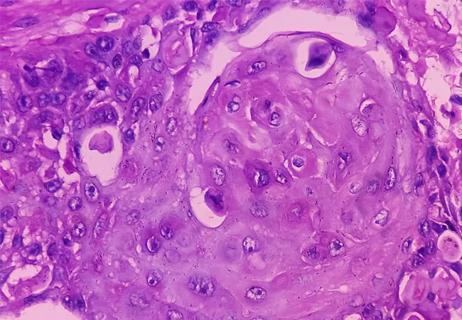Advertisement
Case highlights importance of early screening, multimodal treatment

In October 2020, a 39-year-old woman presented to Cleveland Clinic Cancer Center with a recurrence of advanced rectal adenocarcinoma. The year before, her disease was diagnosed at another institution as stage III (T3N2M0); it was treated with chemotherapy, chemoradiation and surgery, but unfortunately the cancer recurred very quickly.
Advertisement
Cleveland Clinic is a non-profit academic medical center. Advertising on our site helps support our mission. We do not endorse non-Cleveland Clinic products or services. Policy
The patient’s first treatment regimen included eight cycles of FOLFOX (folinic acid, 5-fluorouracil [5-FU] and oxaliplatin) plus chemoradiation with capecitabine. That was followed by an abdominopelvic resection with end colostomy, right pelvic lymph node dissection and right lateral pelvic lymph node dissection.
Three months later, still at the outside institution, the woman was found to have stage IV metastatic disease in a soft-tissue tumor in her right pelvic side wall and right common iliac lymph node. Her right ureter also was entrapped by the pelvic side wall tumor. She then was treated with FOLFIRI (folinic acid, 5-FU and irinotecan) plus bevacizumab.
“Disease in the pelvic sidewall is difficult to treat, and the patient wanted to explore all her options,” explains Cleveland Clinic oncologist Suneel Kamath, MD. “She reached out via our Virtual Second Opinion program, which provided her access to a team of medical experts that offered a multimodal approach.”
Dr. Kamath’s first recommendation was to intensify the patient’s chemotherapy to FOLFOXIRI (folinic acid, 5-FU, oxaliplatin and irinotecan) with bevacizumab. She received that regimen for four months before undergoing stereotactic body radiation therapy (SBRT). A total of 40 Gy was delivered in five fractions over a five-day period.
The patient underwent multidisciplinary surgery at Cleveland Clinic in May 2021, led by colorectal surgeon Emre Gorgun, MD, who performed an exploratory laparotomy with excision of the soft-tissue tumor, right salpingo-oophorectomy and deep lateral pelvic lymph node dissection. The surgery also included 1) mobilization of the right ureter by urologist Hadley Wood, MD; 2) complex en bloc ligation of the right external iliac vein and internal iliac artery and ligation of the right epigastric artery by vascular surgeon Lee Kirksey, MD; and 3) intraoperative radiation therapy (15 Gy x 1 fraction) delivered by radiation oncologist Ehsan Balagamwala, MD.
“The number of surgical specialties represented in the operating room was amazing, as was the complexity of the procedures performed,” says Dr. Kamath. “This patient might not have been considered a candidate for surgery at another institution, but we achieved full resection of the tumor and reconstruction of several important structures.”
Advertisement
During the surgery, the team noted that the preoperative radiation the woman had undergone had eradicated her tumor. She had no major complications following the surgery and has required no additional treatment. Computed tomography scans of her chest, abdomen and pelvis, done in September, and magnetic resonance imaging of her pelvis, done in October, show no evidence of disease. Although the patient is at high risk of recurrence and will need to be monitored closely, she is free of cancer.
“This case is unusual, not only because of the multimodal approach but also the age of the patient,” explains Dr. Kamath. “It underscores the unfortunate rise of young-onset colorectal cancer. Thirty years ago, the median age at onset of colorectal cancer was 72 years. It has fallen to 66 years, and we are seeing more cases in patients in their 20s and 30s.”
The take-home message for clinicians, according to Dr. Kamath, is to never assume that hemorrhoids are the sole cause of rectal bleeding in a young person. “If a patient has classic symptoms, do a colonoscopy instead of simply prescribing stool softeners or a change in diet,” he says. “It’s far better to perform a potentially unnecessary diagnostic test than delay the diagnosis of a potentially deadly disease.”
According to the National Cancer Institute, cases of colorectal cancer in patients under age 50 have grown by more than 50% since the 1990s.
Cleveland Clinic recently established a Center for Young-Onset Colorectal Cancer, which is dedicated to the management and research of cases like this one. Younger patients often have diagnostic and treatment considerations that are specific to their age. A colorectal cancer diagnosis can interrupt their most productive years. The specialized center, which provides a comprehensive personalized care plan for each patient, features a multidisciplinary team that includes specialists in surgery, oncology, radiation therapy, genetics, gastroenterology, fertility, psychology and lifestyle medicine.
Advertisement
Advertisement

Study demonstrates superior visualization of occult primary lesions

New device offers greater tumor control for malignant liver lesions

Patient factors and cancer characteristics are key to deciding between focal therapies and whole gland treatment

Rare cancer presents as unresolved changes of the nipple

Are we ready for ‘observation’ of lesions found on core needle biopsy?

Two-day procedure prevents neurologic compromise for octogenarian

Preoperative chemotherapy enables successful surgical resection

Study finds high levels of a CD8 T-cell subpopulation to be predictive of ICI resistance